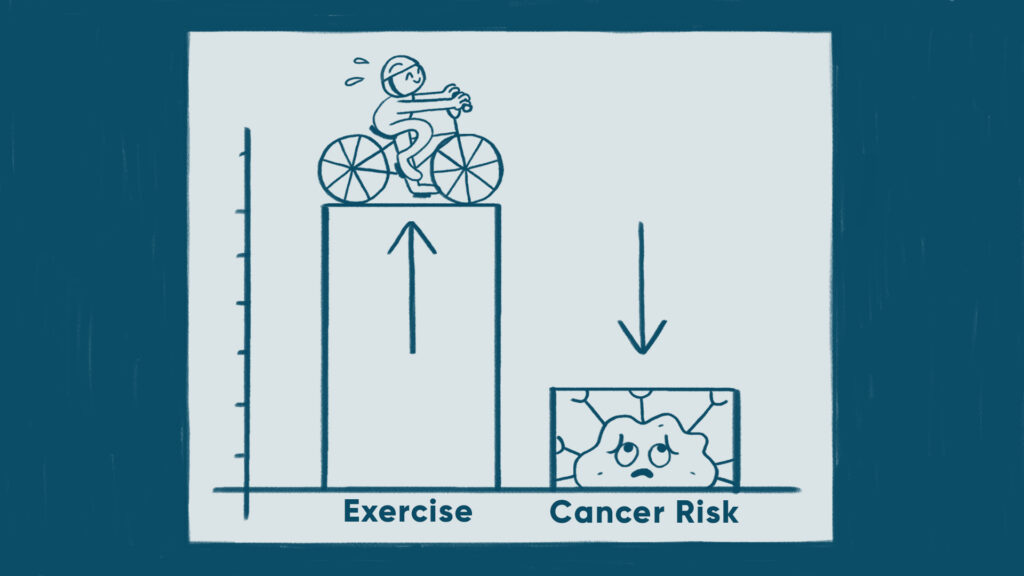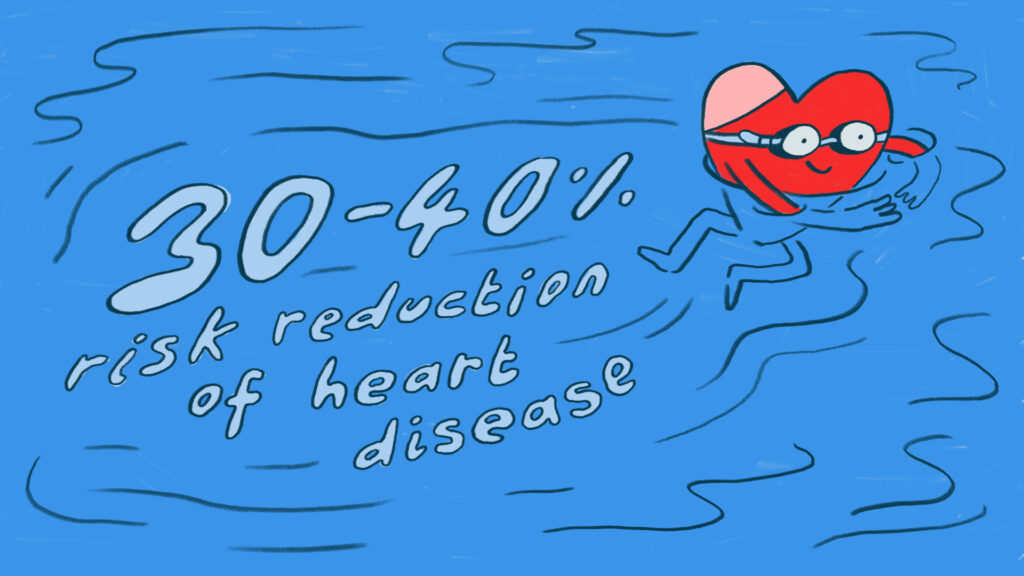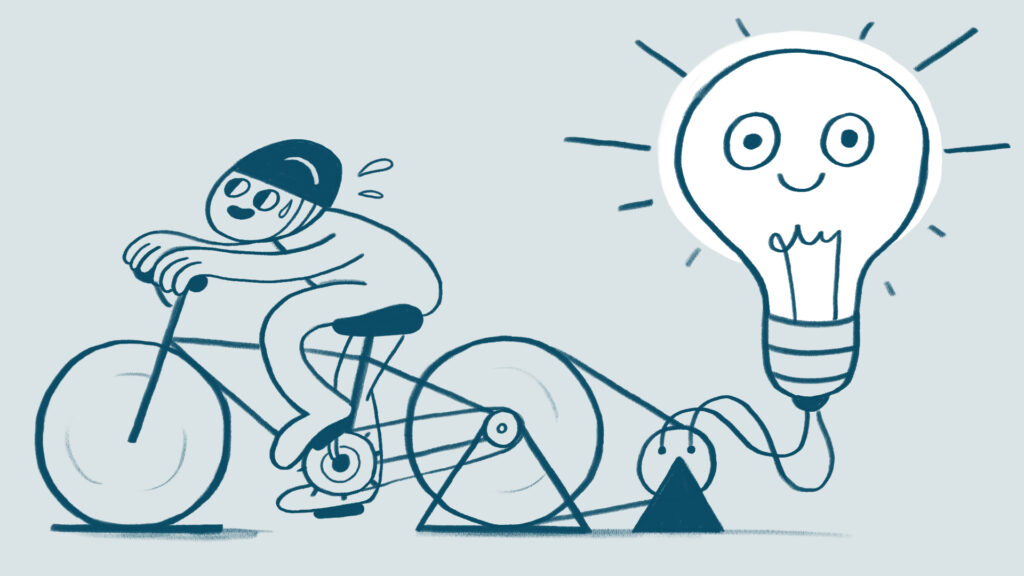The Magic of Exercise11 min read

People who exercise live longer. But what if you don’t want to live longer? (skit with two people here). Ok, well, people who exercise also have better sleep. Ok, but what if I don’t care about sleep? Ok, well, people who exercise also have better memory and cognition, reduced anxiety, depression, and improved quality of life.1-3 Well, what if– I must stop it there. If you don’t care about an enhanced quality of life or living longer, there are bigger issues to deal with.
Beyond those things, exercise has made me genuinely feel better. It keeps me on a schedule. It has made me countless friends. It gets me time in nature. It calms me down. It’s fun.
This post will discuss exercise, why it’s so amazing, and how to start.
What is Exercise?
Physical exercise is when you participate in some activity that increases your breathing and heart rate. The breathing and heart rate increase because some cells in your body require more energy, which, at some point, use oxygen. We breathe faster to get more oxygen into our blood, and our heart pumps faster to deliver more oxygenated blood to our peripheral tissues.
Also, when exercising, our peripheral tissues generate CO2 as a byproduct and need to get that out of the body.
When people are very sick, say their respiratory rate is extremely low from an opioid overdose, their blood becomes acidic. They can’t get enough CO2 out of their blood because they aren’t exhaling enough, and downstream reactions of a higher CO2 in the blood lower the blood pH; their blood becomes deadly to themselves.
Some final interesting statistics about exercise4,5:
- Cardiac Output (how much blood your heart pumps per minute) can increase 5x during exercise.
- Ventilation (how much air passes through your lungs per minute) can increase 20x during exercise.
- Muscle blood flow can increase 80x during exercise.
But why exercise? Sure those bonus abilities of our body is excellent, but who cares?
Of the 56 million people that died in 2017, according to the IHME and Our World in Data, nearly half were killed by cardiovascular disease and cancer.6,7
So nearly 50% of the causes of death are cardiovascular disease and cancer; what if exercise could lower these numbers?
Exercise and Cancer
The #2 killer, 10.08 million people’s cause of death, was various cancers. In the US, that number was 599,601.
Does exercise affect cancer? Yes, let’s get happy for a second here. In one study from 2019, which combined nine prospective cohort studies and followed 755,459 people for ten years, exercise and cancer incidence were measured.
They compared people’s activity by metabolic equivalent task (MET) hours per week which is the total number of metabolic equivalent task hours you complete per week. One MET is your baseline, so laying down and doing nothing for one hour is one MET hour. Walking for one hour is 3.5 MET hours. Running at an 8.5-minute mile pace for one hour is 11 MET hours. This study only included leisure-time physical activity for METs. So if you walk for one hour a week but otherwise do absolutely nothing, your total MET hours, in this study, would be 3.5. More exercise, more MET hours.
Specifically, engagement in 7.5-15 MET hours/week (2.5-5 hours/week of moderate-intensity activity such as brisk walking or weight-lifting) compared to no activity at all showed:

- 8-14% reduced risk of colon cancer
- 6-10% reduced risk of breast cancer
- 10-18% reduced risk of endometrial cancer
- 11-17% reduced risk of kidney cancer
- 14-19% reduced risk of myeloma
- 18-27% reduced risk of liver cancer
- 11-18% reduced risk in non-Hodgkin lymphoma
Walking 30 minutes a day, five days a week, or going for a 40-minute run twice a week hits these numbers.
Here’s the cool part, there was a statistically significant dose-response curve for exercise and cancer. That means the more exercise, the greater the associated lowering of risk of cancer.8
Check out the complete guide from the US Department of Health here.
Exercise and Heart Disease
The leading cause of morbidity and mortality worldwide, killing 659,041 in the US and 18.56 million worldwide, is cardiovascular disease.
Exercise lowers your risk of cardiovascular disease, plain and simple.
Specifically, these recommendations come from the American college of cardiology and the American heart association because of the association between exercise and lower blood pressure and optimized lipid levels.9
One study looked at over 400,000 people, associated activity levels, cardiovascular disease (CVD), and coronary heart disease (CHD). The results spoke so strongly to the researchers that they even said activity levels might cause lower rates of CHD and CVD. Remember, that’s a strong statement; correlation does not equal causation. We need empirical association, the temporal priority of the independent variable, and nonspuriousness to claim a causal relationship.11 We need statistically significant evidence; it has to make sense on a time scale and be biologically plausible.
many plausible biological mechanisms demonstrated in randomized clinical trials (discussed in other other articles in this review) strongly support a causal relationship.
That’s huge.
Furthermore, we see an amazing dose-dependent inverse relationship between levels of physical activity and rates of cardiovascular disease. Remember that means increasing levels of exercise, to a degree, is associated with decreasing the risk of cardiovascular disease.
Compared to the least active people, the most active people have a 30-40% risk reduction of CHD or CVD.

Initial benefits come at 150 minutes per week of moderate aerobic physical activity, with additional benefits occurring at 300 minutes per week.
Exercise and Depression

Depression is the leading cause of disability worldwide, the most common mental disorder, and a significant contributor to the global disease burden.12 It affects 280 million people across the globe and, at its worst, can lead to suicide.
Who or what can save this vast number of poor suffering people? Well, doctors are our best bet. After that, however, exercise can work magic.
One review article updated in 2013 looked at 39 trials comparing exercise and no treatment, exercise compared to psychological therapies, exercise compared to alternative therapies (such as light therapy), and exercise compared with pharmacological treatments. The primary outcome was levels of depression using either the Beck Depression Inventory or the Hamilton Rating Scale for Depression.13
They amazingly found a significant positive effect for exercise vs. doing nothing and no difference between exercise and psychological therapy or pharmacological treatment on the primary outcome of levels of depression. So, exercise is significantly better than nothing and is non-inferior to psychological therapy and pharmacological therapy. However, the latter results were based on only a few small trials, and speak to your doctor before trying anything I discuss. (This is not medical advice in any way, please speak to your doctor about that). Also, why not just add exercise to whatever you do instead of stopping other things?
The authors further suggested more exercise sessions have a greater effect and that fewer sessions and resistance and mixed training were more effective than aerobic training.
Finally, outside of clinical depression, a systematic review of 23 studies, including six randomized controlled trials, found a positive relationship between physical activity and happiness.14
How to Start Exercising
Exercise is amazing. It’s magic. The only thing that has positively impacted my life more than exercise is good sleep and good relationships. That’s it. Nothing else beats it for me. Nothing else beats exercise, no fulfillment in work, not a diet, not nature time. Exercise makes every aspect of my life better.
So how would I start exercising if I did no exercise at all?
- Talk to my doctor and tell them I am interested in exercising.
- Do my research and take a look at the evidence-based recommendations. There is an excellent PDF from the department of health which I will link to here, but at a basic level, I would aim for these numbers from that document:
- A minimum of 150 minutes of moderate intensity* exercise or 75 minutes of vigorous** exercise
- A goal of greater than 300 minutes of moderate-intensity exercise or 150 minutes of vigorous exercise
- Two or more days a week of muscle-strengthening activity involving all muscle groups
*(Moderate intensive activity is 3-5.9 METs including walking briskly or raking the yard)
**(Vigorous activity is greater than 6.0 METs including running or a fitness class)
3. Find one fun activity that also exercises that I will look forward to (mine is playing soccer) and plan that at least once a week.
4. Add weight lifting with a personal trainer or the guidance of a knowledgeable friend at least twice a week.
5. Fill the rest of the time to hit the above goal of 300 minutes with walking or hiking.
Summary
Overall, exercise can decrease our risk of dying from the two most common killers in the world, cancer, and cardiovascular disease, and alleviate the most common disability in the world, depression.
I would begin exercising by speaking to my doctor, aiming for greater than 300 minutes a week, picking a fun activity, and adding weight lifting and walking to get to that 300 minutes after factoring in the fun activity and weight lifting.
There is one final thing I want to mention, the positive feedback loop and positive leak of exercise on life. When you exercise and you enjoy it, it makes you want to do it more. You become healthier. Your body physically starts to become addicted to exercise; you can exercise more and want to exercise more. Finally, training will lead to a healthier body and mind, and this healthier body and mind leaks into the rest of your life: relationships, sleep, studying, work – everything gets better.
Exercise is magic.
Work Cited:
- Cassilhas RC, Tufik S, de Mello MT. Physical exercise, neuroplasticity, spatial learning and memory. Cell Mol Life Sci. 2016 Mar;73(5):975-83. doi: 10.1007/s00018-015-2102-0. Epub 2015 Dec 8. PMID: 26646070.
- Kelley GA, Kelley KS. Exercise and sleep: a systematic review of previous meta-analyses. J Evid Based Med. 2017 Feb;10(1):26-36. doi: 10.1111/jebm.12236. PMID: 28276627; PMCID: PMC5527334.
- Mora JC, Valencia WM. Exercise and Older Adults. Clin Geriatr Med. 2018 Feb;34(1):145-162. doi: 10.1016/j.cger.2017.08.007. Epub 2017 Oct 10. PMID: 29129214.
- Fu Q, Levine BD. Exercise and the autonomic nervous system. Handb Clin Neurol. 2013;117:147-60. doi: 10.1016/B978-0-444-53491-0.00013-4. PMID: 24095123.
- Sarelius I, Pohl U. Control of muscle blood flow during exercise: local factors and integrative mechanisms. Acta Physiol (Oxf). 2010 Aug;199(4):349-65. doi: 10.1111/j.1748-1716.2010.02129.x. Epub 2010 Mar 26. PMID: 20353492; PMCID: PMC3157959.
- https://ourworldindata.org/causes-of-death
- https://www.cdc.gov/nchs/fastats/leading-causes-of-death.htm
- Matthews CE, Moore SC, Arem H, Cook MB, Trabert B, Håkansson N, Larsson SC, Wolk A, Gapstur SM, Lynch BM, Milne RL, Freedman ND, Huang WY, Berrington de Gonzalez A, Kitahara CM, Linet MS, Shiroma EJ, Sandin S, Patel AV, Lee IM. Amount and Intensity of Leisure-Time Physical Activity and Lower Cancer Risk. J Clin Oncol. 2020 Mar 1;38(7):686-697. doi: 10.1200/JCO.19.02407. Epub 2019 Dec 26. PMID: 31877085; PMCID: PMC7048166.
- Eckel RH, Jakicic JM, Ard JD, de Jesus JM, Houston Miller N, Hubbard VS, Lee IM, Lichtenstein AH, Loria CM, Millen BE, Nonas CA, Sacks FM, Smith SC Jr, Svetkey LP, Wadden TA, Yanovski SZ; American College of Cardiology/American Heart Association Task Force on Practice Guidelines. 2013 AHA/ACC guideline on lifestyle management to reduce cardiovascular risk: a report of the American College of Cardiology/American Heart Association Task Force on Practice Guidelines. J Am Coll Cardiol. 2014 Jul 1;63(25 Pt B):2960-84. doi: 10.1016/j.jacc.2013.11.003. Epub 2013 Nov 12. Erratum in: J Am Coll Cardiol. 2014 Jul 1;63(25 Pt B):3027-3028. PMID: 24239922.
- Sattelmair, Jacob, et al. “Dose response between physical activity and risk of coronary heart disease: a meta-analysis.” Circulation 124.7 (2011): 789-795.
- Shiroma, Eric J., and I-Min Lee. “Physical activity and cardiovascular health: lessons learned from epidemiological studies across age, gender, and race/ethnicity.” Circulation122.7 (2010): 743-752.
- https://www.who.int/news-room/fact-sheets/detail/depression
- Cooney GM, Dwan K, Greig CA, Lawlor DA, Rimer J, Waugh FR, McMurdo M, Mead GE. Exercise for depression. Cochrane Database of Systematic Reviews 2013, Issue 9. Art. No.: CD004366. DOI: 10.1002/14651858.CD004366.pub6. Accessed 08 October 2022.
- Zhang, Z., Chen, W. A Systematic Review of the Relationship Between Physical Activity and Happiness. J Happiness Stud 20, 1305–1322 (2019). https://doi.org/10.1007/s10902-018-9976-0
1 Comment
Why you're always tired (it's not sleep) - Zach Highley · December 30, 2024 at 12:01 pm
[…] Exercise is a magical energy generator. If you only listen to one thing, listen to this section. Doctors, researchers, and centenarians worldwide repeat it over and over: exercise more. […]